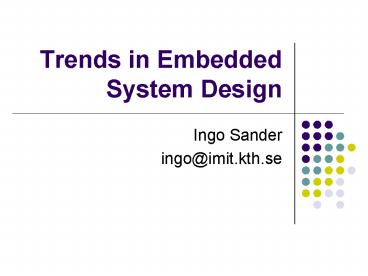Trends in Embedded System Design - PowerPoint PPT Presentation
1 / 11
Title:
Trends in Embedded System Design
Description:
... or design new instructions for the critical part = improved architecture ... Xtensa processors can be used as parts of a system-on-chip architecture ... – PowerPoint PPT presentation
Number of Views:2291
Avg rating:3.0/5.0
Title: Trends in Embedded System Design
1
Trends in Embedded System Design
- Ingo Sander
- ingo_at_imit.kth.se
2
Motivation for Configurable Processor Cores
- Observations
- Time-to-market is critical
- Development time for software is much smaller
than for hardware - Hardware can be customized and has much better
performance than software solution
3
Why Configurable Processor Cores?
- Idea
- Combine the advantages of hardware and software
in form of a customizable processor to achieve - Clearly shorter Time-To-Market than hardware
- Clearly better performance than software
- Provide a processor platform with a basic
architecture that can be extended - by additional optimized units (MAC,
Floating-Point Unit) - Own instructions together with own customized
hardware can be defined for the processor
4
Example for a configurable processor Xtensa
(Tensilica)
- The Xtensa processor core
- Targets system-on-chip applications
- Is configurable, extensible and synthesizable
- Has
- Base Instruction Set Architecture
- Configurable Functions (Parametrized)
- Optional Functions
- Designer-Defined Functions and Registers (For
Accleration of Specific Algorithms)
5
Xtensa Processor Core
6
Basic Xtensa Core
- 32-bit architecture
- Base configuration
- 32-bit ALU
- Up to 64 general purpose registers
- 6 special purpose registers
- 80 base instructions
- Improved 16- and 24-bit RISC instruction encoding
7
Optional Architecture
- Execution Units
- Multipliers, 16 and 32 bits
- MAC-Unit, Floating-Point Unit
- Interface Options
- Memory Subsystem Options
- Memory Management Options
- Local Data and Instruction Caches
- Separate RAM, ROM Areas for Data and Instruction
8
Tensilica Extension Language
- The Tensilica extension language is used to
describe new instructions, registers and
execution units that are then automatically added
to the Xtensa processor
9
Xtensa ProcessorDesign Process
10
Design Flow
- Choose basic Xtensa processor
- Specify algorithm in C
- Compile to Target Processor
- Profile and check, if design constraints are met
- If constraints are met, everything is fine,
otherwise - Choose optional functions (e.g. Multiplier) or
design new instructions for the critical part gt
improved architecture - Adjust your code for the new architecture
- Go back to 3.
11
Summary
- The Xtensa concept provides
- Not only a configurable architecture
- But also a design methodology
- The idea is to take the best of both the hardware
and the software world in order to - Have good performance
- Short Time-to-Market
- Xtensa processors can be used as parts of a
system-on-chip architecture - Other extendable cores exist like the NIOS II
from Altera































